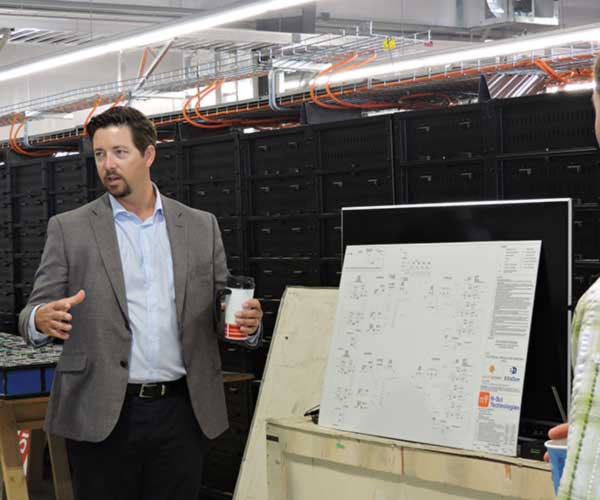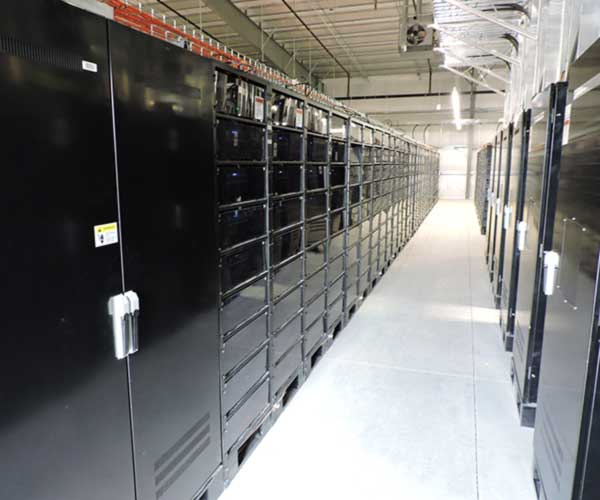A recent tour of Canada’s biggest battery allowed participants to get up close to an 8.8MW/40MWh lithium-ion array housed in an otherwise unremarkable looking shed in the Wright Industrial Park in Stratford, Ontario.
“This is a historical moment,” says Stefan Goertz, Director of Development of Energy Services for Saturn Power, EPC contractor (in a joint venture with Ellis Don) and co-developer (with Hecate Energy). “But in the future, we’re going to see a lot more of this.”
The $20 million Stratford Festival Hydro battery, manufactured (and 50 percent owned) by Powin Energy, was procured under the IESO’s Energy Storage Procurement framework. Saturn has since secured another contract for a 25 MWh/50 MW facility under a separate RFP for regulation services.

Stefan Goertz, Director of Development of Energy Services, Saturn Power, presenting the electronic details of the Festival Hydro battery facility /Shane Mulligan
The Stratford facility will provide reactive power and voltage support to help with Stratford’s growing demand. But it is ultimately a testing facility, where IESO and other participants can learn how a massive dispatchable battery can help manage Ontario’s grid.
A small desktop setup with three screens is “the brains of the whole operation,” says Goertz. “Through this portal, IESO remotely controls the whole facility.” In fact, there are no permanent personnel on site; most days it sits unoccupied, just a big battery beside a transformer station.
In the long run, though, this battery may be the seed of a local micro-grid.
“Can we put in solar there as well and have a true micro-grid operating in the heart of our industrial park?” asks Ysni Semsedini, CEO of the local distributor Festival Hydro. “It would be something very unique to Stratford.”
Indeed, as PV continues to grow and disrupt grids with duck-curve regularity, storage is increasingly seen as a prerequisite to further PV growth.

One of 14 battery banks in the Stratford battery site, with inverter cabinets on the right /Shane Mulligan
As Tyler Hamilton writes, “Energy storage is critical for the growth of renewables because simply put, the wind doesn’t blow all the time and the sun doesn’t always shine. The only way to get much larger amounts of renewables reliably into a country’s electricity mix – and give coal the boot – is to capture that clean energy when it’s available, and dispatch it when it’s needed most.”
Ontario’s grid operators have only begun to add modern storage technologies. Our primary storage is still the 170 MW Sir Adam Beck facility at Niagara Falls, the only pumped hydro storage in Canada; by comparison, there are over 30 facilities in the U.S., providing 22 GW capacity.
The modern storage being procured by IESO is more distributed and responsive than Adam Beck; the first 50 MW of procurement has included flywheels, hydrogen, thermal and compressed air storage, as well as both flow and solid batteries.
Meanwhile, Saturn and others are finding a growing market among Class A or ICI customers for behind-the-meter systems that can lower their Global Adjustment charges.
Residential batteries can now be included alongside Net Metering, where they can provide vital backup power.
The solar + storage model is also being tested at scale by utilities including Oshawa Power and Alectra with its Power House project. This approach gets even more interesting when aggregation enters the mix, which could eventually open the door to virtual power plants like Tesla is trying in Australia.
EVs can also play a part, but vehicle-to-grid power seems stuck at the pilot stage. Yet as electrification grows, other approaches could include grid-integrated battery storage for electric trains and even hydrogen storage for GO trains or vehicle fleets in a power-to-gas scenario.
While Ontario may not be in the lead on storage compared to Korea, Australia or California, it has recognized storage as a “game-changing technology” in the Long-Term Energy Plan, promised support for new private storage installations, and also convened an Energy Storage Advisory Group that is examining market and regulatory obstacles to allow more competition in the sector.
With our new government, the immediate future of these programs may be less certain than we would like. But in the long run, global trends are stronger than election platforms, and Ontario will hopefully continue to find a solid role for storage technologies.












Comments